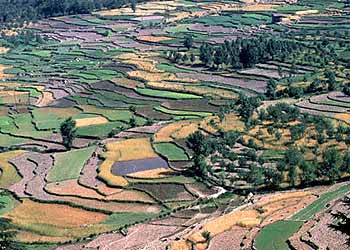Kullu Travel Guide:

Introduction
Kullu, once known as Kul-anti-peetha - "the end of the habitable world", is the capital town of the Kullu District, in the state of Himachal Pradesh, India. It is located on the banks of the Beas River in the Kullu Valley about ten kilometres north of the airport at Bhuntar. Kullu is a broad open valley formed by the Beas river between Manali and Largi. This valley is famous for the beauty and its majestic hills covered with Pine and Deodar Forest and sprawling Apple Orchards.The course of the Beas river presents a succession of magnificent, clad with forests of Deodar, yowering above trees of Pine on the lower rocky ridges. Kullu valley is sandwiched between the Pir Panjal, Lower Himalayan and Great Himalayan range.
History
Kullu (1220m) was once known as Kulanthpitha - `the end of the habitable world`. Beyond rose the forbidding heights of the Greater Himalayas, and by the banks of the shining river Beas, lay the fabled `Silver Valley`.
The Chinese pilgrim monk Xuanzang visited the Kullu Valley in 634 or 635 CE. He describes it as a fertile region completely surrounded by mountains, about 3,000 li in circuit, with a capital 14 or 15 li in circumference. It contained a tope built by Ashoka said to mark the place where the Buddha preached to the local people and made conversions. There were some twenty Buddhist Monasteries, with about 1,000 monks, most of whom were Mahayanist. There were also some fifteen Hindu temples and people of both faiths lived mixed together. There were meditation caves near the mountain passes inhabited by both Buddhist and Hindu practitioners. The country is said to have produced gold, silver, red copper, crystal lenses and bell-metal.
"Thus, Ku-zu is the Bu-nan name for Ku?u. . . . Dr. Vogel in his MS. notes on Lahul gives Ku-zu? as the Gari (Bu-nan) name of Ku?u. Ku-zu? is the locative case of Ku-zu. He adds that Ku?u is called Ram-ti by the people of Ti-nan, and Ram-di by those of Ca?sa (Me-rlog). The Tibetans call it Ñu?-ti."
Kullu got its first motorable access only after Indian Independence. The long centuries of seclusion have however allowed the area to retain a considerable measure of its traditional charm. The road through the Kullu Valley and Lahaul is now paved all the way connecting, and providing the major access route between the northern Indian plains to Leh in Ladakh.
Geography
Kullu has an average elevation of 1,362 metres (4,469 feet). The town of Kullu lies on the bank of River Beas. A major tributary Sar-vari, (derived from "Shiv -Baardi") leads to the less explored and steeper Lug-valley on the west. On the east of Kullu lies a broad mountainous ridge having the village-temples of Bijli Mahadev, Mount Nag and Pueed. Beyond the ridge lies Manikaran valley, along the Parvati river which joins Beas in Bhuntar. On the South of Kullu lie towns of Bhuntar, Out(leading to Anni, Banjar and Siraj Valley) and Mandi(a separate district). Historically Kullu was accessible from Shimla via Siraj valley or through passes on the west leading to Jogindernagar and onto Kangra. To the north lies the famous town of Manali, which through the Rohtang pass leads onto the Lahaul and Spiti Valley. Once can see an enormous change in the climate as one climbs up the windward side of the ranges to proceed to the leeward and much drier plateaus to the north of Manali.
Demographics
As of 2010[update] India census, Kullu had a population of 110320. Males constitute 54% of the population and females 46%. Kullu has an average literacy rate of 81%, higher than the national average of 59.5%: male literacy is 84%, and female literacy is 77%. In Kullu, 10% of the population is under 6 years of age.
Kullu Valley
Kullu Valley is the largest valley in the Kullu district, in Himachal Pradesh, India. The Beas River runs through the middle of the valley. It is also called the "Valley of the Gods".
It connects with the Lahul and Spiti valleys via Rohtang Pass, situated at 13,051 ft (3,978 m), 51 km from Manali city.
Culture
Kullu Valley, also known as the "Valley of Gods", is well known for the seven day festival of Kullu Dussehra, a celebration of the mythical Lord Rama's victory over the evil king Ravana. The festival takes place in the months of October or November, depending upon the Hindu calendar.
Due to it being the commercial and economic center, the township of Kullu has had an eclectic influx of nearby village/district inhabitants, shop owners and government employees from bordering states who give a different feel from the rest of the valley. This has also contributed to a stronger sports and educational infrastructure in the town.
Vicinity
Other places of interest in the area include Manikaran (famous for its hot springs) and hot water springs at Vashisht village near Manali, 40 km north of Kullu, a hub for tourists and rock climbers. Malana, Kaish-Dhaar in Lug Valley, Bijli Mahadev, Bhekhli and Bajaura house the famous temples of the region and places like Kasol and Gohar. Manali is perhaps the most famous town and center of all tourist attractions in the state. Manali also has a well-known temple dedicated to the mythical princess Hadimba.
The economy of the town largely depends on tourism, horticulture (apples, plums, pears, and almonds) and handicrafts (shawls, caps, etc.).
Hotels in Kullu
There are many Hotels and Guest Houses in Kullu to stay. Kullu lies in the heart of the 70 km long Kullu Valley and offers a central location for sight-seeing to Manali and the Rohtang Pass in the north to the Shoja and Jalori passes in the south. Manikaran is about 40 km to the east. The airport is only 7 km away in Bhutar which is the nearest Airport for Kullu-Manali.